Tamoxifen regulates ferroptosis of hepatocytes by targeting SLC1A5 to activate hepatic stellate cells and liver fibrosis
IF 4.7
2区 医学
Q1 BIOCHEMISTRY & MOLECULAR BIOLOGY
引用次数: 0
Abstract
Tamoxifen (TAM) is a commonly used drug for breast cancer treatment, mainly inhibiting estrogen receptors to prevent tumor growth. Although TAM has achieved remarkable effects in clinical treatment, recent studies have shown that TAM can cause drug-induced liver injury. However, it's still unclear whether long-term use of TAM can cause liver fibrosis. This study explores whether long-term administration of TAM can cause liver fibrosis and its mechanism. We found that TAM could induce liver injury in mice and significantly up-regulate the expression of activation markers of stellate cells, activating the TGF-β/smad signaling pathway. Additionally, TAM induced an inflammatory response and activated the NF-κB signaling pathway. More importantly, we demonstrated for the first time in vivo and in vitro that TAM-induced hepatocyte ferroptosis, accompanied by glutathione (GSH) depletion, reactive oxygen species (ROS) accumulation, and intracellular ferrous enrichment, and changes in the expression of ferroptosis-related proteins. Ferroptosis inhibitors such as ferrostatin-1 (Fer-1) and DFO ameliorated ferroptosis in hepatocytes. However, these ferroptotic events did not occur in macrophages and hepatic stellate cells (HSCs). Co-culture experiments showed that TAM-induced hepatocytes could increase expression of liver fibrosis-related proteins in HSCs, but this could be abolished by ferroptosis inhibitors. Bioinformatics analysis suggested TAM may regulate hepatocyte ferroptosis through solute carrier family 1 member 5 (SLC1A5). Downregulation of SLC1A5 could inhibit TAM-induced hepatocyte ferroptosis, thereby alleviating HSCs activation and the increased expression of ECM proteins. Our study suggests that TAM induces hepatocyte ferroptosis through SLC1A5, leading to HSC activation and liver fibrosis.
他莫昔芬通过靶向SLC1A5激活肝星状细胞和肝纤维化调节肝细胞铁下垂。
他莫昔芬(TAM)是一种常用的乳腺癌治疗药物,主要通过抑制雌激素受体来阻止肿瘤生长。虽然TAM在临床治疗中取得了显著的效果,但最近的研究表明TAM可引起药物性肝损伤。然而,长期使用TAM是否会导致肝纤维化尚不清楚。本研究探讨长期服用TAM是否会导致肝纤维化及其机制。我们发现TAM可诱导小鼠肝损伤,显著上调星状细胞激活标志物的表达,激活TGF-β/smad信号通路。此外,TAM诱导炎症反应并激活NF-κB信号通路。更重要的是,我们首次在体内和体外证明了tam诱导的肝细胞铁凋亡,伴随着谷胱甘肽(GSH)的耗竭、活性氧(ROS)的积累和细胞内亚铁的富集,以及铁凋亡相关蛋白表达的变化。铁下垂抑制剂如铁抑素-1 (fer1)和DFO可改善肝细胞的铁下垂。然而,在巨噬细胞和肝星状细胞(hsc)中没有发生这些铁致下沉事件。共培养实验表明,tam诱导的肝细胞可以增加hsc中肝纤维化相关蛋白的表达,但这可以被铁下垂抑制剂所消除。生物信息学分析提示TAM可能通过溶质载体家族1成员5 (SLC1A5)调控肝细胞铁下垂。下调SLC1A5可抑制tam诱导的肝细胞铁下垂,从而减轻hsc的活化和ECM蛋白的表达增加。我们的研究表明TAM通过SLC1A5诱导肝细胞铁下垂,导致HSC活化和肝纤维化。
本文章由计算机程序翻译,如有差异,请以英文原文为准。
求助全文
约1分钟内获得全文
求助全文
来源期刊
CiteScore
7.70
自引率
3.90%
发文量
410
审稿时长
36 days
期刊介绍:
Chemico-Biological Interactions publishes research reports and review articles that examine the molecular, cellular, and/or biochemical basis of toxicologically relevant outcomes. Special emphasis is placed on toxicological mechanisms associated with interactions between chemicals and biological systems. Outcomes may include all traditional endpoints caused by synthetic or naturally occurring chemicals, both in vivo and in vitro. Endpoints of interest include, but are not limited to carcinogenesis, mutagenesis, respiratory toxicology, neurotoxicology, reproductive and developmental toxicology, and immunotoxicology.

 求助内容:
求助内容: 应助结果提醒方式:
应助结果提醒方式:


